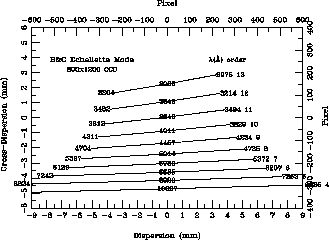


Next: Aperture and Shutter Assembly
Previous: Grating Tilt Adjustment
Up: The Grating
The echellette mode of the spectrograph uses a rather coarse (180
l/mm) grating ruled at a high blaze angle (23.90 ) to yield
1--2Å resolution for multi-order spectroscopy. A sketch of the
optical path is contained as Figure 2.6 (from
Carswell et al. 1975, ApJ, 196, 351). With the 60
) to yield
1--2Å resolution for multi-order spectroscopy. A sketch of the
optical path is contained as Figure 2.6 (from
Carswell et al. 1975, ApJ, 196, 351). With the 60 quartz
cross-dispersion prism and a 1200 pixel CCD, 8 spectral orders
provide continuous coverage from the atmospheric limit to
approximately 8800Å in the format shown in
Figure 2.7. Maximum slit length depends on the
spectral region of interest, reaching a minimum between orders 4 and
5. Thus, a special decker is generally substituted for the standard
slit plate for echellette spectroscopy, providing for slits of
16
quartz
cross-dispersion prism and a 1200 pixel CCD, 8 spectral orders
provide continuous coverage from the atmospheric limit to
approximately 8800Å in the format shown in
Figure 2.7. Maximum slit length depends on the
spectral region of interest, reaching a minimum between orders 4 and
5. Thus, a special decker is generally substituted for the standard
slit plate for echellette spectroscopy, providing for slits of
16 in length with a wide selection of widths. See
chapter 3.1 for details regarding the echellette decker.
in length with a wide selection of widths. See
chapter 3.1 for details regarding the echellette decker.

Figure 2.6: Schematic of echellette mode.

Figure 2.7: Cross-dispersed formats.
Conversion to or from the echellette mode requires considerable
mechanical adjustments to the spectrograph and therefore can only be
carried out by qualified technical staff during the day. Should you
wish to take advantage of the substantial benefits of this mode of
observing, you must notify the technical staff well in
advance of this request!



Next: Aperture and Shutter Assembly
Previous: Grating Tilt Adjustment
Up: The Grating
Pat Hall - Wed Oct 4 11:02:37 MST 1995
 ) to yield
1--2Å resolution for multi-order spectroscopy. A sketch of the
optical path is contained as Figure 2.6 (from
Carswell et al. 1975, ApJ, 196, 351). With the 60
) to yield
1--2Å resolution for multi-order spectroscopy. A sketch of the
optical path is contained as Figure 2.6 (from
Carswell et al. 1975, ApJ, 196, 351). With the 60 quartz
cross-dispersion prism and a 1200 pixel CCD, 8 spectral orders
provide continuous coverage from the atmospheric limit to
approximately 8800Å in the format shown in
Figure 2.7. Maximum slit length depends on the
spectral region of interest, reaching a minimum between orders 4 and
5. Thus, a special decker is generally substituted for the standard
slit plate for echellette spectroscopy, providing for slits of
16
quartz
cross-dispersion prism and a 1200 pixel CCD, 8 spectral orders
provide continuous coverage from the atmospheric limit to
approximately 8800Å in the format shown in
Figure 2.7. Maximum slit length depends on the
spectral region of interest, reaching a minimum between orders 4 and
5. Thus, a special decker is generally substituted for the standard
slit plate for echellette spectroscopy, providing for slits of
16 in length with a wide selection of widths. See
chapter 3.1 for details regarding the echellette decker.
in length with a wide selection of widths. See
chapter 3.1 for details regarding the echellette decker.




